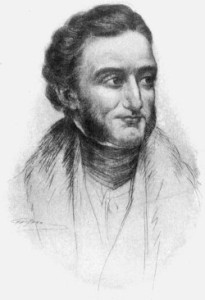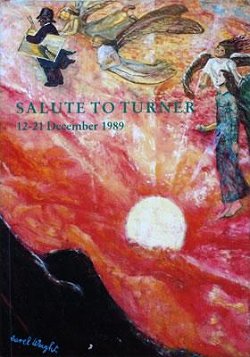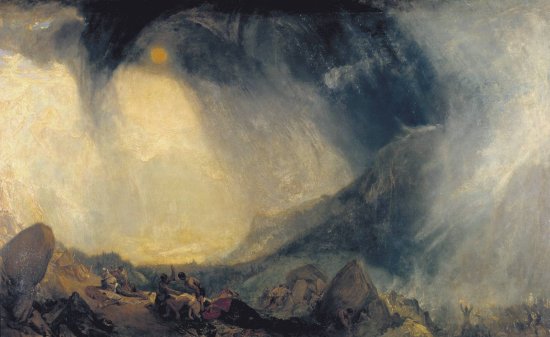Fifty painters have contributed to the “Salute to Turner” exhibition. Andrew Solomon previews it.

Joseph Mallord William Turner (1775-1851)
Every month now offers some event at which the work of the “most highly regarded” artists in Britain is offered up for sale to benefit or assist a vastly reputable charity or cause, and savvy artists position themselves in the galaxy of art-market stars by placing themselves in this monotonous procession of sales. One-man shows seem to be more a ticket to these sales than vice versa; indeed some of these artists may soon be able to give up their galleries altogether. I recently had dinner with friends who had purchased a large painting by a noted British painter. One of the other guests, upon arrival, looked at the canvas in question, and said, “That’s new, isn’t it?” The host nodded. “The Chelsea Arts Club?” the guest asked. “AIDS,” the host responded.
On 12 December, the National Trust opens an exhibition of paintings at Agnew’s. Torn, clearly, between the excitement of an auction and joviality of a Christmas exhibition, the National Trust and Agnew’s have decided to meld the two. The works included will be shown at Agnew’s for ten days. During that time, anyone who wishes to do so may place bids on the paintings, which will be chalked up next to them. These bids must exceed posted reserved prices (which start at about £1,000). On 21 December, there will be a bright and Christmassy party for all bidders at which the highest bids will be announced to an anxious crowd. Everyone will then have the opportunity to place higher bids for the works they most want. At the end of the evening, buyers will be able to take away their paintings — gift-wrapped in the virtue of charity supported. It is hoped that the exhibition will raise £150,000; half will go to the artists, the other half to the Trust.

Salute to Turner: 12-21 December 1989
Though the Agnew’s exhibition is no more distinguished than the others like it which have been opening with clockwork regularity all year, it is also no less distinguished than those others. Like them, it includes work a few notches beyond competence, work which neither aspires to nor achieves profundity, but which is decorative and reasonably visually interesting. It does not enrich one’s vision of art, but it sometimes enriches one’s vision of the seaside, and since the people who buy it tend to be rather more interested in the seaside than in art, that is perhaps just as well. Indeed some of the work is charming, and charm is too rare a commodity to dismiss lightly; many the British home, stately or otherwise, to which a dose of charm would be a most welcome addition.
The exhibition is entitled “Salute to Turner.” Some 50 artists have done work inspired by that greatest of English masters, and this shared theme gives the exhibition a coherence that its predecessors have in most instances lacked. “Inspired” is a word subject to loose and various interpretation. There are several paintings — one by Patrick Procktor, for example — that look almost as though they had been done by Turner himself. There are others — such as Gillian Ayres‘s Tondo Isle — whose connection to Turner only the most fertile of imaginations could locate. There are a lot of seascapes, and there are a lot of paintings in shades of yellow and pale grey with funny spots of pink and a lot of ochre fading into brown. There are a lot of paintings in which diffused light is key. There are a lot of paintings in which a certain balance is brought to an idyllic landscape. There are, sadly, no paintings of Hannibal crossing the Alps, but almost every other Turner theme is given its due.

Paintings included in the “Salute to Turner” exhibition. Top: Albert Irvin, Approach 89; second: John Napper, Salute to Turner; third: Len Tabner, Across the Marsh to Holy Island; bottom: Leonard Rosiman, Turner in the Alps.
The exhibition is to benefit the Foundation for Art of the National Trust, a body which commissions new work to go in National Trust properties. Rest assured that the National Trust is not filling the stately homes of England with montages by Gilbert and George. The Foundation for Art commissions work which records or in some other way relates to the houses in which it is placed. Dudley Dodd, Assistant Historic Buildings Secretary of the National Trust and a leading member of the Committee for the Foundation for Art, has said that the photographs taken to show, for example, how a house looks before and after restoration capture its appearance but miss its spirit, and has described the photographs taken after the Great Storm of 1987 as “sterile.” The Foundation for Art commissions pieces from expressive realist artists which are meant to convey the quality of the world of the houses in which they are placed. The Foundation also commissions work that relates to the houses in other ways — portrait busts of the donors of various properties, or reconstructive paintings of now-vanished gardens.
The exhibition at Agnew’s includes much work by artists who have done such pieces for the National Trust, and much work by other artists who might easily do such work, though it also has paintings by artists who could never be commissioned by the Trust. The aforementioned Patrick Procktor, resembling a Turner as it does, is quite a lovely piece; he apparently did it in the Sixties, and hearing the theme for the exhibition, knew that it had at last found its place. There is also a brooding and dramatic work by Len Tabner, who had a solo exhibition at Agnew’s this autumn, and there are capable watercolours by David Gentleman, as well as a smattering of rather uninspired abstract painting. But the best works are the ones that are quirky, a bit confused, and rather charming, works whose character echoes that of the National trust itself. John Napper has done a wonderful painting, titled simply Salute to Turner, in which one of those overbalanced classical landscapes of which Turner himself was so fond is reproduced, but flattened and primitivised. Because a critic with a bias toward Angst recently accused Napper of “avoiding flagellation,” he has peopled his delicate landscape with angry peasants with whips, adding flagellation — in the literal sense — to his oeuvre. Equally delightful is a watercolour by Leonard Rosoman of Turner in the Alps, looking very much like Hannibal, with fallen assistants scattered around his carriage; he himself sits wrapped in a long coat, oblivious to the discomfort his efforts have engendered. Carel Weight‘s image of Turner ascending to heaven became familiar when it was used for the publicity for the Royal Academy‘s summer exhibition, and a new variation on the same theme shows up at Agnew’s; a delightfully whimsical piece which successfully realises its own aspirations. Here there is nothing portentous. The National Trust is at its best when it escapes its own pretensions; so too artists of the calibre included in this exhibition. If the Trust commissions new work from this smattering of whimsical artists, they will genuinely bring to their recording of events a lightness that photography cannot match.

Not on display at the “Salute to Turner” exhibition, but rather at the Tate: J.M.W. Turner, Snowstorm: Hannibal and His Army Crossing the Alps, 1810-12. Source: Wikimedia Commons.











